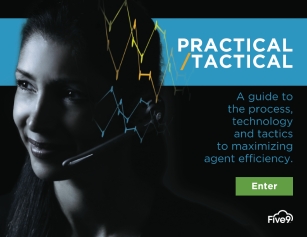
We’ve shared our own success with the content pillar approach. But we also want to share the stories of others. So we talked to Pat Oldenburg, Five9’s Senior Manager of Content Marketing, to hear how his team’s first content pillar launch went. (Hint: It went really well.)
Five9, a Kapost client, is a leading provider of cloud contact center software. They provide software that enables contact centers to improve customer connections while reducing costs and increasing productivity.
Getting Started with Content Marketing
When Oldenburg joined Five9, the marketing team was just beginning to develop original content.
They started by producing and promoting two videos. The videos were clever, but more oriented towards detailing the benefits of Five9’s products. Despite the time and money they invested, these videos stopped producing leads and engagement after two or three weeks. Once the promotion budget dried up, Oldenburg says, the ROI “died off.”
Integration Leads to Productivity
Oldenburg and his team decided it’s next initiative would be a content pillar anchored with the launch of Five9’s first buyer-centric eBook, “Practical/Tactical: A Guide to Maximizing Agent Efficiency.”
At first, the task seemed daunting. There were plenty of channels and roles that would need to be supported by the eBook. But Oldenburg said following the content pillar framework made thinking through the workflows and ideal buyer journey for the campaign much easier.
“The content pillar helped organize our thoughts and efforts,” Oldenburg said.
Five9 created 63 different assets repurposed from the eBook, compared to the 22 assets supporting the video launch. The increased production coincided with an increase in productivity across teams. That didn’t happen by accident. It was the result of moving collaboration and production from email and spreadsheets to a visible workflow, calendar and centralized distribution process within a centralized content marketing platform.
“A lot of groups were producing assets, but weren’t collaborating together,” says Oldenburg.”People can see all the assets, [gives] them more skin in the game,” Oldenburg says. “Everyone started pitching in more”
Thinking About Buyers’ Interest First
Before the “Practical/Tactical” eBook, Five9 focused exclusively on product-centric content. “This [eBook] was the first asset for us that talked about a buyer need,” Oldenburg admitted. “Specifically our contact center manager persona.”
A shift in mindset was one thing. Now Oldenburg and his team needed to find out which issue was burning in the minds of potential customers.
They didn’t need a radical solution. They simply asked their audience what kind of content they needed by issuing a survey. “We were pretty honest with them,” says Oldenburg.” “We said we want to produce content that’s of interest to you.”

The results were conclusive. Buyers wanted help improving contact center agent efficiency. They had a theme.
While Oldenburg was convinced, the concept of spending time and resources on an asset that didn’t talk up the company’s product wasn’t universally embraced. “In the past, we usually went forward with a product-centered piece,” Oldenburg says. “The biggest hurdle was getting people’s minds away from our product.”
The results of the campaign would turn the skeptics into believers.
Here Come the Leads
Five9 started to reap some big benefits from their pillar approach in the first month.
The eBook drove 4X as many leads, and 3x as many closed deals as the company’s previous campaign.
There were so many leads coming in, the head of digital marketing had to turn off the notifications hitting his inbox.
Meanwhile, the lead development reps were reporting some of the best prospect conversations they ever had. And the head of sales was asking if they could send it to all Five9 customers.

“Leading with the campaign first was initially tough. But after the pillar effort, everyone is in-line with this integrated approach.”
The executive team was taking notice, too, Oldenburg said. The CMO deemed it a “world class piece of content” and printed out copies for Five9’s board. With that kind of support, content pillars went from an intriguing experiment to an entrenched strategy within the company’s marketing.
“Leading with the campaign first was initially tough. But after the pillar effort, everyone is in-line with this integrated approach.”
So What’s Next?
Five9 plans to duplicate and expand this pillar effort in quarters to come. They’re holding their first content board meeting next week to discuss other content themes and customer pain points that they can address with another pillar in the next quarter. And they are dedicating the budget they threw at their videos to create other pillar-supporting pieces of content like infographics.
The results speak for themselves. Leading with buyer-centric content, and using content pillars to drive truly integrated campaigns, isn’t just a nice theory. Put into practice, this kind of content operation brings in leads and revenue.
Use this story if you need help convincing your team.

